How changing perspectives mask the dramatic transformation of our coral reefs
Off the southern coast of Florida, USA, a 354-kilometer (220-mile) chain of 1,700 islands called the Florida Keys forms a curved border between the Atlantic Ocean and the Gulf of Mexico. These islands run parallel to a significant portion of the Florida Reef Tract—the third-largest barrier reef system in the world—which has historically been a vibrant consortium of life, supporting thousands of marine species and creating one of North America's most spectacular underwater landscapes.
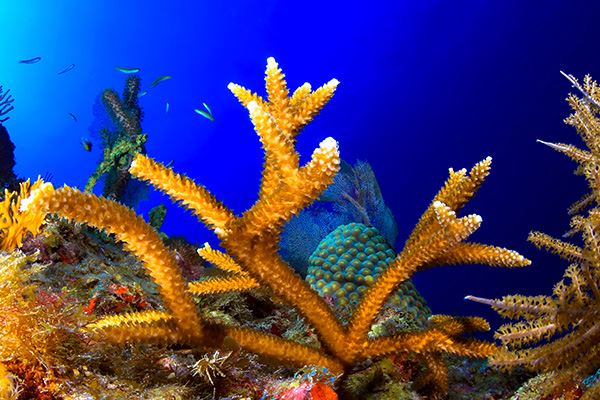
Healthy staghorn coral at the Florida Keys National Marine Sanctuary.
For generations, these reefs amazed visitors with diverse corals, creating a complex three-dimensional habitat. However, this ecosystem has undergone a tragic transformation. The Florida Keys have lost over 90% of their live coral in just 40 years.1
This dramatic decline represents what scientists call the "shifting baseline syndrome"—each new generation accepts the environmental conditions they first observe as normal, unaware of what existed before. Today's snorkelers and divers swim above what is essentially a reef graveyard, though the colorful fish and waving sea fans create an illusion of health that masks the truth.
"If you're a non-diver from Iowa and you come down to the Florida Keys for vacation, you see all these sea fans moving back and forth—and tons of fish," explains Jon Fajans, Applications Manager at Xylem and contract diver. "You think, 'Oh, my gosh, these reefs are awesome!'"
What today's visitors don't realize, Fajans points out, is that the rocky foundation beneath those sea fans once consisted of living coral colonies. "The massive formations of coral that once helped break up wave action and created habitat have largely disappeared within a single generation."
In 2023, this longstanding decline accelerated as exceptionally warm waters triggered the worst coral bleaching event ever recorded in the Florida Keys. Water temperatures on the reef reached up to 34 °C (93 °F)—which is 2.8 °C (5 °F) above normal2—pushing these already stressed ecosystems to their breaking point.
Understanding coral: The animal behind the reef
To understand why rising temperatures have such devastating effects on Florida's reefs—and why losing 90% of live coral is so significant—we must first recognize that corals are not plants or rocks. They're animals covered in tiny polyps, each with a central mouth surrounded by tentacles. Hard corals, also known as reef-building or stony corals, secrete calcium carbonate to build their skeleton, creating the massive structures that form reefs.
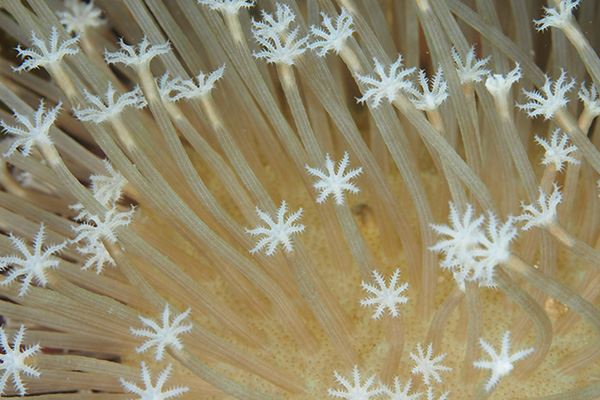
Each coral polyp has a mouth surrounded by tentacles. This image, captured by Jon Fajans, shows an example of an organ pipe coral (Tubipora musica).
A coral’s success depends on a remarkable partnership with microscopic algae called zooxanthellae (a type of dinoflagellate) that live within their tissue. These algae—responsible for giving coral its color—photosynthesize during the day, providing up to 70% of the nutrients reef-building corals need to survive.3
While mutually beneficial, this relationship between coral and zooxanthellae can be surprisingly fragile. When corals become stressed, they can expel their symbiotic algae in a process known as coral bleaching. Once they lose their primary food source, corals only have weeks for the algae to return before they die.
When corals turn white: The bleaching crisis
This fragile relationship between coral and zooxanthellae explains why ocean temperature changes have such devastating impacts. Elevated temperatures of just 1 °C (2 °F) above the normal seasonal maximum can trigger bleaching,4 though it can also be induced by unusually low temperatures.
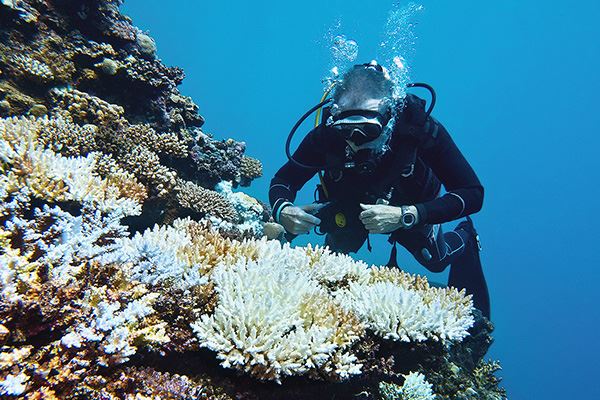
A scuba diver inspects bleached corals.
The destructive bleaching event of 2023—where researchers observed 100% bleaching on many of Florida’s reefs2—demonstrates how quickly these temperature thresholds can be crossed.
Each major bleaching event resets our baseline further as new divers and researchers arrive to study what remains rather than what once was. What would have been deemed a catastrophic loss of coral cover decades ago is now accepted as the standard condition of Florida's reefs.
Although temperature is the primary driver of coral bleaching, the full story is more complicated than temperature measurements alone might suggest.
The hidden dynamics of bleaching
"Coral bleaching often results from a combination of factors working together," Fajans explains. "The typical scenario involves high water temperatures combined with intense sunlight, which stresses corals on the upper surfaces of the reef. But we also see cases where corals on the undersides of formations bleach while those on top remain healthy."
These unusual bleaching patterns often relate to water movement and low dissolved oxygen (DO) levels. Many nearshore currents tend to taper off significantly if there’s a week or two of very slight winds. Without these currents, oxygen levels can plummet in the early morning hours—around 3:30 to 5:30 a.m.—as the coral's symbiotic algae consume oxygen at night.
"In still, warm water, these algae can deplete so much oxygen that it stresses the coral," says Fajans. "The coral's response is to expel the algae—'Get out, I need to breathe'—resulting in bleaching."
Researchers find it extraordinarily challenging to capture conditions that are ripe for coral bleaching in real time, especially pre-dawn oxygen depletion—unless they have the right tools.
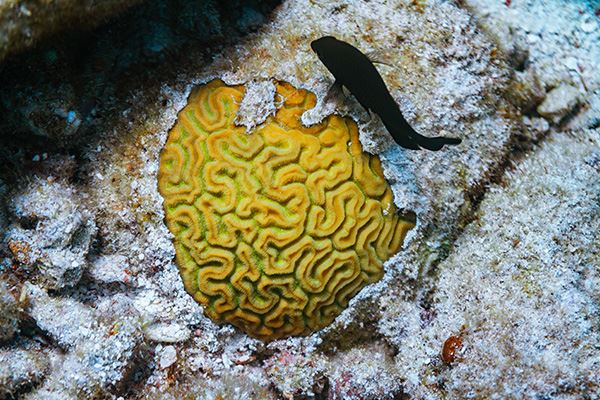
When stressed, corals expel the symbiotic algae responsible for giving them their color, initiating bleaching. This photo shows a healthy, colorful brain coral near Key Largo, Florida.
Monitoring for understanding and protection
To address this challenge, water monitoring systems are used to track multiple parameters simultaneously. Through years of data collection and analysis, these systems have enabled the development of models that can forecast potential bleaching events.
Comprehensive monitoring of water quality parameters is not just essential for understanding current reef conditions or predicting bleaching events—it provides crucial context for coral surveys and visual documentation efforts.
By correlating environmental factors with observed changes in coral health, scientists create a more complete picture of reef dynamics. These combined datasets help fight against the shifting baseline syndrome by establishing the environmental conditions that once supported thriving coral communities versus those associated with decline.
Advanced monitoring tools
For monitoring coral reefs, two primary types of instruments stand out, each serving different research needs:
The Aanderaa SeaGuardII Doppler Current Profiler (DCP) is uniquely positioned to track the relationship between water movement and bleaching events. "We can put a current meter and water quality sensors—such as DO, conductivity, temperature, and turbidity—on the SeaGuardII," Fajans explains.
“It’s a small, mobile platform with a built-in data logger and enough battery power to deploy for up to two years. We can set it on a tripod and place it on the seabed right next to a coral reef, and it will measure the currents, water quality measurements, and light—it can log all of that.”
The YSI EXO2 Multiparameter Sonde is ideal for researchers focused primarily on water quality parameters rather than currents. These versatile instruments are key components in large-scale monitoring networks.
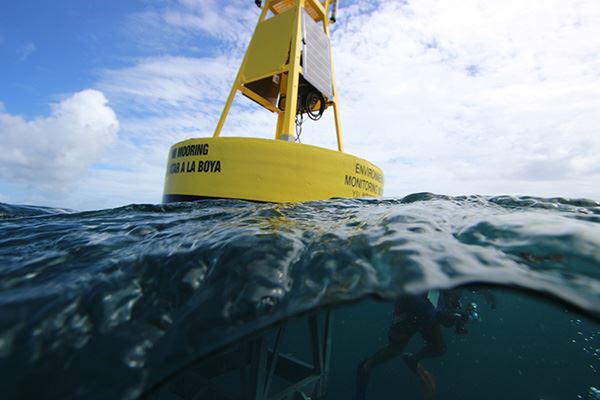
Monitoring buoys along the Florida Reef Tract collect vital water quality data. Photo credit: John Fajans.
“About four years ago, a new monitoring program—a collaboration between the Florida Department of Environmental Protection and Florida International University—was launched that focused monitoring efforts along the Florida Reef Tract,” Fajans says. “Each station features a YSI data buoy and an EXO2 Sonde. These sondes are placed on the bottom to collect water quality measurements, with data transmitted in near-real time to researchers and resource managers."
This monitoring network captured a historic moment in the summer of 2023. “The warmest water temperature ever recorded off the coast of Florida—over 38.3 °C (101 °F) in Manatee Bay just north of the Keys—was measured with an EXO,” Fajans notes.
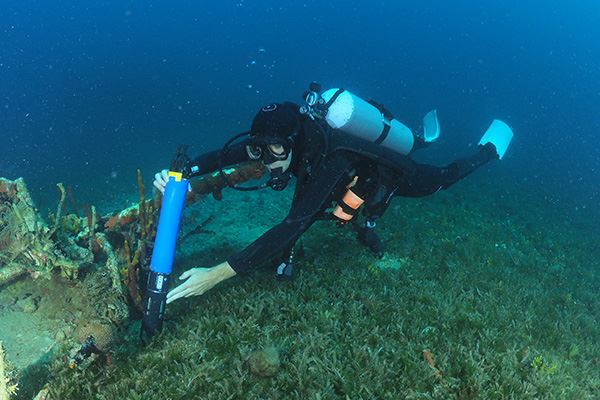
A new monitoring program along the Florida Reef Tract relies on EXO2 Sondes to monitor parameters such as dissolved oxygen, pH, temperature, and turbidity. Photo credit: Jon Fajans.
Solving the data transmission challenge
Getting data from seafloor instruments to researchers in real time presents significant challenges.
“It's very difficult to run a cable from an instrument on the seabed up to a buoy—and it would take a very expensive inductive mooring or inductive swivel to get that data up,” Fajans explains.
New technologies are emerging to solve this problem. "Electromagnetic modems, like the EM2 from CSignum, can send signals directly through the water column and air to an antenna on a buoy," says Fajans. "This eliminates the need for cables, noisy acoustic modems, and in-water transducers."
These technological advancements provide unprecedented insight into reef conditions, helping scientists detect early warning signs of stress.
Looking forward: Preservation efforts
While the situation in the Florida Keys is serious, efforts are underway to protect the remaining coral populations—and prevent the coral graveyard from becoming even more populated. In 2023, scientists mobilized to preserve coral genetic diversity when massive bleaching threatened Florida's reefs.
“Scientists came together to go out and recover the genomes,” Fajans recalls. "They saved small pieces of every species of coral they could get their hands on." These samples are now preserved at facilities such as the Florida Aquarium, the University of Florida, and Mote Marine Lab.
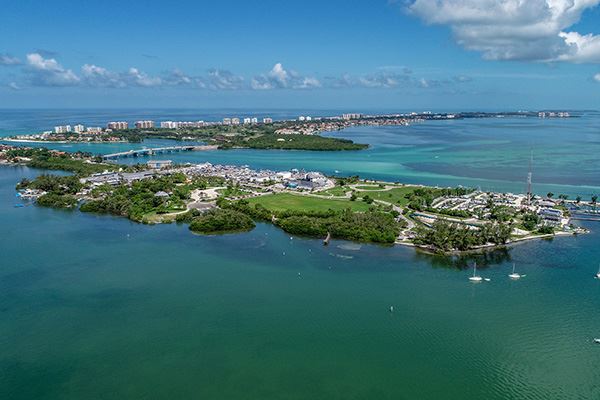
Mote Marine’s primary research campus encompasses 10.5 acres on City Island (shown here) in Sarasota, Florida..
These preservation efforts represent a crucial line of defense against the shifting baseline syndrome. By maintaining living examples and genetic material from coral species that may soon disappear from Florida's reefs, scientists are creating a biological archive of what these ecosystems once contained.
Researchers are also studying corals that show greater resistance to heat stress, though Fajans cautions that scaling up such efforts remains challenging. "To be able to reproduce those species and then transplant them out in meaningful numbers to save an area the size of the Great Barrier Reef, the Florida Reef Tract, or the Mesoamerican Reef, we're nowhere near anything on that kind of scale."
Beyond the reef: A global warning system
The message from our coral reefs extends far beyond their underwater boundaries. As Fajans points out, "We're paying attention to the coral reefs, but that same ecosystem collapse could be said for just about any of our nearshore environments."
From the disappearance of 10 billion snow crabs in the Bering Sea to changes in salmon spawning patterns, the changes we observe in coral reefs herald broader transformations in our oceans.
The shifting baseline syndrome affects not just coral reefs but all marine ecosystems. Mass die-offs of marine species that would have been considered catastrophic events if they happened suddenly decades ago have become normalized in today's context of ongoing environmental decline.
Our acceptance of these losses as the "new normal" represents perhaps the greatest danger to conservation efforts.
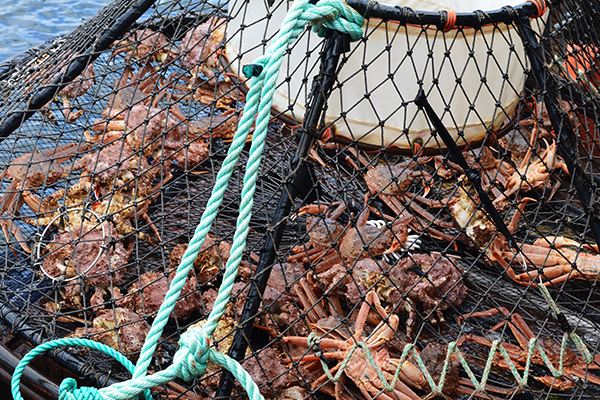
The recent disappearance of 10 billion snow crabs in the Bering Sea is one of many alarming changes in our marine ecosystems.
From monitoring to action: Restoring Florida's reefs
Understanding these changes—and working to address them—requires maintaining our connection to the past. Scientists are increasingly turning to historical data, sediment cores, and long-lived coral skeletal records to establish "reference conditions" that show what healthy reefs looked like before major human impacts. These baselines help researchers set realistic restoration goals and measure progress.
In the Florida Keys, this historical perspective has informed NOAA's Mission: Iconic Reefs initiative—a first-of-its-kind approach to restoring seven ecologically and culturally significant reef sites. Launched in 2019, this project aims to restore these reefs to approximately 25% coral cover, a threshold scientists consider necessary for ecosystem health and resilience.1
"This effort represents one of the most ambitious coral restoration projects in the world," says Fajans. "By focusing on these iconic sites and using historical data to guide restoration targets, we're creating living laboratories that can help us understand and address the challenges facing all reefs."
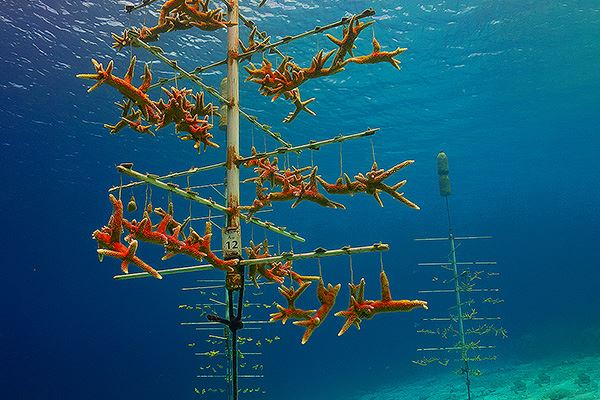
Ocean-based nurseries—some of which are partners in NOAA's Mission: Iconic Reefs initiative—grow coral fragments on specialized underwater structures. Check out missioniconicreefs.org for the latest on the program, including a results dashboard.
Despite its critical importance, the initiative faces new challenges. The Key Largo office of the Florida Keys National Marine Sanctuary is slated for closure, meaning the northern reefs must now be supported from the Key West facility—located about 160 kilometers (100 miles) away. While the program isn't at immediate risk, this closure will impact operations and stretch support budgets.
For environmental professionals and concerned citizens alike, supporting coral monitoring and conservation efforts remains crucial. This means advocating for continued funding of monitoring programs, applying pressure on government agencies and lawmakers to maintain restoration initiatives like Mission: Iconic Reefs, reducing local stressors like pollution and overfishing, and addressing climate change at both personal and policy levels—all of which contribute to preserving what remains of these invaluable ecosystems.
As monitoring technology advances, our ability to detect and understand coral stress events improves. These innovations, combined with large-scale restoration efforts, represent our best hope for reversing the shifting baseline—ensuring that future generations will not only know what healthy reefs once looked like, but might actually witness the rebirth of Florida's underwater landscapes.

ADDITIONAL INFORMATION
The perfect storm: Multiple threats to coral reefs
Beyond rising temperatures and bleaching events, Florida's coral reefs face numerous threats.
- Boat traffic: Boats can damage seagrass beds, increasing turbidity and sedimentation that can cover corals. Boat anchors and divers touching reefs damage delicate coral animals.
- Decline of the long-spined urchin: The mass die-off of these important algae grazers has allowed nutrients from Florida's agricultural runoff to fuel excessive algal growth, smothering coral.
- Harmful sunscreens: Certain sunscreen ingredients can be lethal to corals.
- Invasive species: Without any natural predators, the invasive Indo-Pacific lionfish consumes vast numbers of native fish species that are important to the overall health of the coral community.
- Marine debris: Improperly disposed trash, such as plastics, can cause physical damage or infection.
- Stony coral tissue loss disease: A devastating, multi-year disease outbreak has resulted in significant tissue loss and mortality for hard coral throughout the Florida Reef Tract.
Building climate-resilient corals5
Scientists are racing to develop heat-resistant corals before warming oceans cause irreversible damage. While large-scale bleaching events threaten reefs, researchers are exploring innovative interventions, including:
- Experimental evolution: Growing coral symbionts (microbial partners) under elevated temperatures to select heat-tolerant strains, with the goal of deploying these globally.
- Probiotic treatments: Using beneficial bacteria to protect corals from disease.
- Microbiome manipulation: Transplanting heat-resistant symbionts into vulnerable corals, strengthening their microbial defenses against heat stress.
- Early detection systems: Developing technology to identify chemical stress signals before visible bleaching occurs, helping researchers anticipate and respond to stress events.
- Coral documentation: Recording and studying coral species before they disappear.
While these efforts offer some relief, scientists stress they are not a long-term solution. According to researchers, there's only about a decade before reef damage becomes irreversible—making both scientific interventions and substantial reductions in greenhouse gas emissions crucial for coral survival.
NOAA's Mission: Iconic Reefs is reversing decades of decline1
Coral cover is a measure of how much of the reef surface is covered by live coral rather than other organisms, such as algae. Hard coral coverage in the Florida Keys currently sits at about 2%, but it’s estimated that this coverage was once up to 40%.
In response to the dramatic decline of Florida's coral reefs, NOAA and partners launched Mission: Iconic Reefs in 2019—an unprecedented effort to restore seven ecologically and culturally significant coral reef sites within the Florida Keys National Marine Sanctuary.
A phased approach
Mission: Iconic Reefs uses a science-based, phased approach to restoration. Sites are prepared by removing competing species like algae, then corals are introduced.
- Phase 1: With a goal to restore hard coral cover to 15%, this phase involves:
- Phase 1A: Restoring fast-growing elkhorn coral to quickly increase habitat complexity.
- Phase 1B: Adding diversity with star, brain, pillar, and staghorn corals, along with algae eaters like urchins.
- Phase 2: Introduce slower-growing hard corals to reach the target of 25% coral cover—the threshold scientists consider necessary for a healthy, self-sustaining ecosystem.
Throughout all phases, sites receive ongoing maintenance and monitoring, including debris removal and predator control.
Check out missioniconicreefs.org for the latest on the program, including a results dashboard.
Sources:
- NOAA, Restoring Seven Iconic Reefs: A Mission to Recover the Coral Reefs of the Florida Keys
- Florida Fish and Wildlife Conservation Commission, Coral Bleaching
- NOAA, Coral Basics
- Smithsonian, Corals and Coral Reefs
- National Geographic, The race to create climate-resilient coral—before it's too late